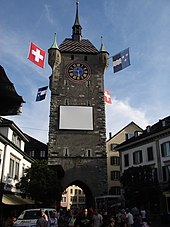City Tower (Baden)

The city tower (originally called the Bruggerturm or Baderturm ) is a gate tower in the old town of Baden in Switzerland . It was built in the middle of the 15th century and served as the northern city gate . Besides the governor's castle , it is the only part of the medieval city fortifications that has been completely preserved. With its striking appearance, the 56.45 meter high tower is a landmark of the city.
Building history
Around 1360 a first tower was built on the northern edge of the old town, but it was removed again around 80 years later. From 1441 to 1448, during the Old Zurich War , Baden was repeatedly attacked by troops from Zurich . During this time, the local foreman Rudolf Murer worked on a new gate tower with a kennel . On November 8, 1445, the tower still under construction resisted a Zurich attack with a battering ram .
In the years 1481 to 1483, the tower was raised by two stories under the direction of Martin Grülich from Brugg and received its final height. In addition, four bay windows , two tower clocks and a roof turret were added. From 1620 to 1623 the tower was given a crenellated forework with defensive turrets and a drawbridge , which the city had expanded into a bastion from 1677 to 1679 as part of the expansion of the fortifications . After their victory in the Second Villmerger War , the people of Zurich destroyed the bastion in 1712 and the tower now had a purely decorative function.
A comprehensive renovation followed in 1755. The bottom floor fell victim to an expansion of the gate from 1842 to 1846; At the same time, heated prison cells were set up on the upper floors . In 1873 a new modern clockwork was installed , in 1925 the tower was renovated again (combined with a further widening of the archway) and placed under monument protection. In 1961, the last gate widening so far took place, the pedestrian paths were relocated in passages in the neighboring buildings. The tower served as a district prison until 1984, since then it has been used sporadically for public events. A storm in 1990 caused severe damage to the roof and the top of the tower, whereupon the top was renewed and coated with copper and the tiles were replaced.
From March 2008 the tower was renovated again. The natural plaster, which contains a lot of cement, was only applied in 1925 and corresponded to the zeitgeist of that time ( Heimatstil ). In previous centuries the tower had always had a coat of paint. In 1977 the plaster was impregnated ; Gradually, however, moisture penetrated through cracks, which is why the plaster had to be completely renewed. In addition, considerable structural damage to the facades was found in 2004. The work was completed in June 2009, and since then the tower has returned to the state it was in before 1925.
building
The city tower, formerly called the Brugger or Baderturm to distinguish it from the Mellingerturm, which was demolished in 1874, forms a passage between Weiten Gasse and Schlossbergplatz. Until the opening of the bypass road through the Schlossberg tunnel in 1965, the gate was a bottleneck for through traffic. Since then, only RVBW bicycles and buses have been allowed to pass through it.
The roughly square floor plan has a side length of 10.9 by 10.4 meters. The height is 56.45 meters, which means that the tower clearly towers above the other buildings in the old town (with the exception of the parish church Maria Himmelfahrt ). The masonry consists entirely of plastered limestone from the surrounding area, while the corner blocks are made of sandstone , which comes from a quarry in Mägenwil . The steep hipped roof over the tower shaft is covered with glazed tiles in the city colors black, red and white in a rafter pattern. A hexagonal roof turret made of copper rises above it . Four polygonal, expansive bay windows adorn the corners of the top floor.
The building has numerous decorations. There is a stone relief plate above the northern archway facing away from the city. This depicts the double-headed eagle of the Holy Roman Empire in color , including twice the Baden coat of arms and the inscription "anno domini MCCCCXLI" (in the year of the Lord 1441). It is the oldest surviving representation of the city's coat of arms. The south facade is characterized by a late Baroque fresco painted in 1793 on an ocher yellow background, which frames the clock tower and a separate sundial. The clock face of the tower clock is light blue, hands and numerals are gold-plated.
The tower of 1892-1898 by Gustav Gull built Swiss National Museum in Zurich , however, designed a copy of Baden's city tower a little less detailed. In 2006, the Swiss Post published a special stamp with the city tower as a motif as part of the national stamp exhibition .
literature
- Peter Hoegger: The art monuments of the canton of Aargau . Ed .: Society for Swiss Art History . Volume VI, District of Baden I. Birkhäuser Verlag, Basel 1976, ISBN 3-7643-0782-X , p. 74-79 .

